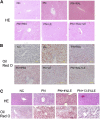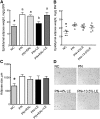Lipid emulsion administered intravenously or orally attenuates triglyceride accumulation and expression of inflammatory markers in the liver of nonobese mice fed parenteral nutrition formula
- PMID: 23325918
- PMCID: PMC3713017
- DOI: 10.3945/jn.112.169797
Lipid emulsion administered intravenously or orally attenuates triglyceride accumulation and expression of inflammatory markers in the liver of nonobese mice fed parenteral nutrition formula
Abstract
The accumulation of hepatic TG and development of hepatic steatosis (HS) is a serious complication of the use of parenteral nutrition (PN) formulas containing a high percentage of dextrose. But whether fat emulsions or other nutrients can ameliorate the induction of HS by high-carbohydrate diets is still uncertain. We hypothesized that administration of a lipid emulsion (LE; Intralipid) and/or the vitamin A metabolite retinal (RAL) will reduce hepatic TG accumulation and attenuate indicators of inflammation. C57BL/6 male mice were fed PN formula as their only source of hydration and nutrition for 4-5 wk. In Expt. 1, mice were fed PN only or PN plus treatment with RAL (1 μg/g orally), LE (200 μL i.v.), or both LE and RAL. In Expt. 2, LE was orally administered at 4 and 13.5% of energy to PN-fed mice. All PN mice developed HS compared with mice fed normal chow (NC) and HS was reduced by LE. The liver TG mass was lower in the PN+LE and PN+RAL+LE groups compared with the PN and PN+RAL groups (P < 0.01) and in the 4% and 13.5% PN+LE groups compared with PN alone. Hepatic total retinol was higher in the RAL-fed mice (P < 0.0001), but RAL did not alter TG mass. mRNA transcripts for fatty acid synthase (Fasn) and sterol regulatory element-binding protein-1c (Srebpf1) were higher in the PN compared with the NC mice, but FAS protein and Srebpf1 mRNA were lower in the PN+LE groups compared with PN alone. The inflammation marker serum amyloid P component was also reduced. In summary, LE given either i.v. or orally may be sufficient to reduce the steatotic potential of orally fed high-dextrose formulas and may suppress the early development of HS during PN therapy.
Conflict of interest statement
Author disclosures: K. Ito, L. Hao, A. E. Wray, and A. C. Ross, no conflicts of interest.
Figures





References
-
- Raman M, Allard JP. Parenteral nutrition related hepato-biliary disease in adults. Appl Physiol Nutr Metab. 2007;32:646–54 - PubMed
-
- Braunschweig CL, Levy P, Sheean PM, Wang X. Enteral compared with parenteral nutrition: a meta-analysis. Am J Clin Nutr. 2001;74:534–42 - PubMed
-
- The Future of parenteral nutrition: key players, disease specific opportunities and market forecasts. New York: PR Newswire; 2011
-
- Peyret B, Collardeau S, Touzet S, Loras-Duclaux I, Yantren H, Michalski MC, Chaix J, Restier-Miron L, Bouvier R, Lachaux A, et al. Prevalence of liver complications in children receiving long-term parenteral nutrition. Eur J Clin Nutr. 2011;65:743–9 - PubMed
-
- Javid PJ, Greene AK, Garza J, Gura K, Alwayn IP, Voss S, Nose V, Satchi-Fainaro R, Zausche B, Mulkern RV, et al. The route of lipid administration affects parenteral nutrition-induced hepatic steatosis in a mouse model. J Pediatr Surg. 2005;40:1446–53 - PubMed
Publication types
MeSH terms
Substances
Grants and funding
LinkOut - more resources
Full Text Sources
Other Literature Sources
Molecular Biology Databases
Research Materials
Miscellaneous

